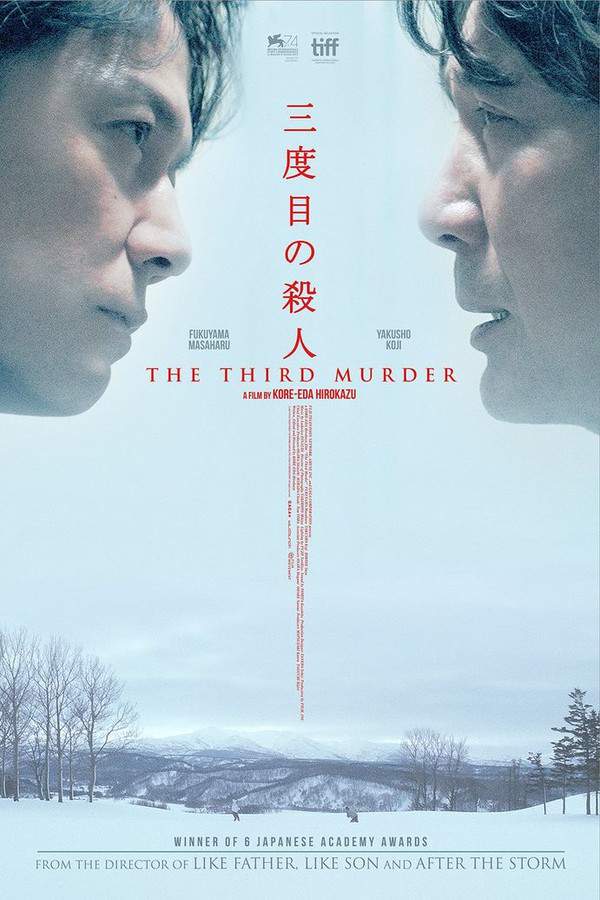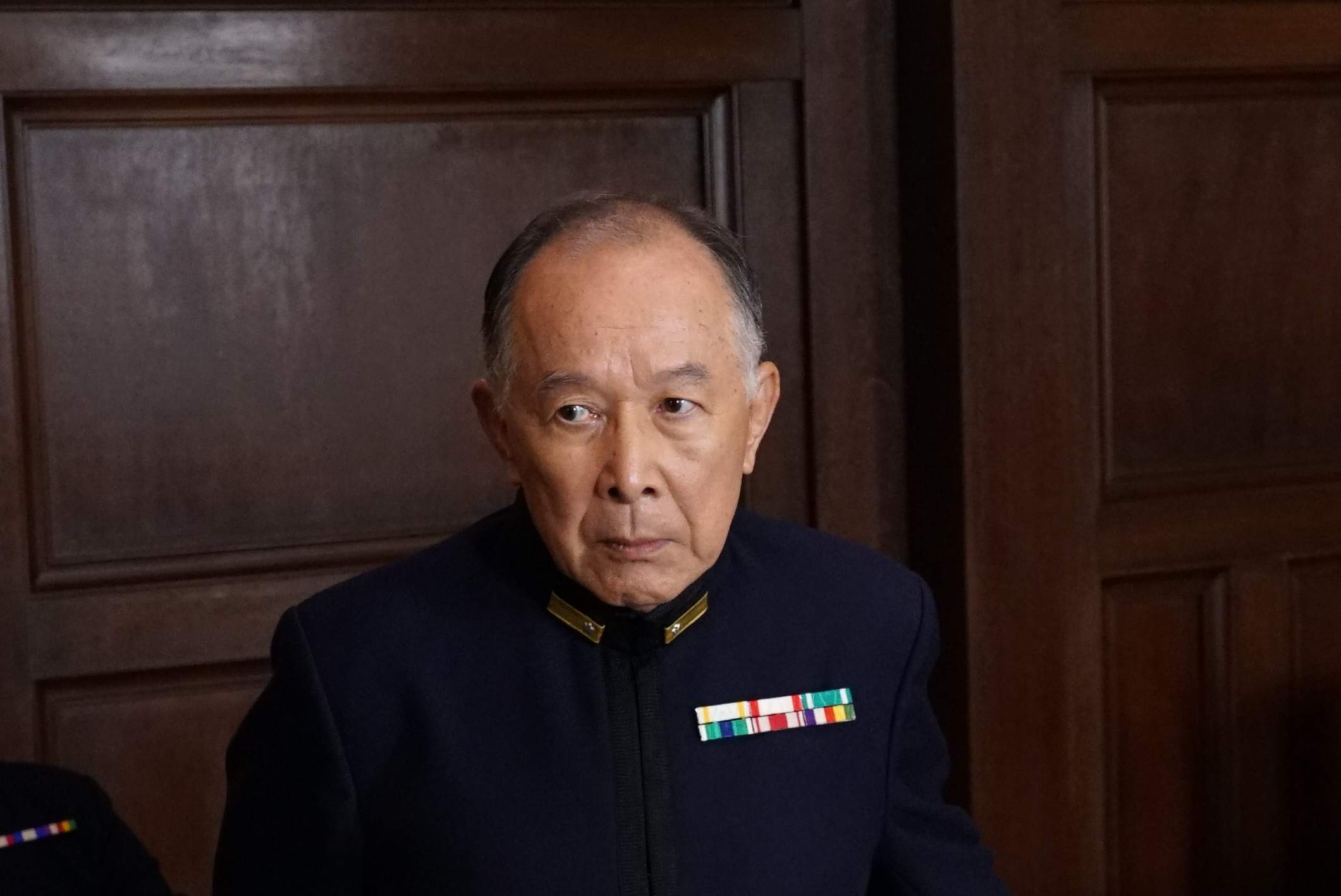The Third Murder 2018

A brilliant lawyer, Shigemori, takes on the defense of Misumi, a man who readily admits to murder. Initially believing the case straightforward, Shigemori soon finds his certainty shaken as unsettling details emerge. As he investigates, the line between guilt and innocence blurs, and he questions everything he thought he knew. The pursuit of justice becomes a complex and unsettling journey, leaving the outcome uncertain and the truth elusive.
Does The Third Murder have end credit scenes?
No!
The Third Murder does not have end credit scenes. You can leave when the credits roll.
Meet the Full Cast and Actors of The Third Murder
Explore the complete cast of The Third Murder, including both lead and supporting actors. Learn who plays each character, discover their past roles and achievements, and find out what makes this ensemble cast stand out in the world of film and television.

Masaharu Fukuyama
Shigemori

Kôji Yakusho
Misumi

Suzu Hirose
Sakie

Shin'nosuke Mitsushima

Izumi Matsuoka
Hattori Akiko

Aju Makita
Shigemori Yuka

Mikako Ichikawa
Sasabara Itsuki

Hajime Inoue
Ono Minoru

Ichirô Ogura

Isao Hashizume
Shigemori Akihisa

Kôtarô Yoshida
Settsu Daisuke

Yuki Saitô
Yamanaka Mitsue
External Links and Streaming Options
Discover where to watch The Third Murder online, including streaming platforms, rental options, and official sources. Compare reviews, ratings, and in-depth movie information across sites like IMDb, TMDb, Wikipedia or Rotten Tomatoes.
Ratings and Reviews for The Third Murder
See how The Third Murder is rated across major platforms like IMDb, Metacritic, and TMDb. Compare audience scores and critic reviews to understand where The Third Murder stands among top-rated movies in its genre.

The Movie Echo Score
The Third Murder delivers a measured exploration of moral ambiguity through restrained pacing and refined craftsmanship. While many critics praised its incisive legal drama and precise framing, others noted occasional narrative fuzziness and emotional detachment that undercut full engagement. The film’s deliberate rhythm and thematic depth earn commendation for intellectual rigor, though some argue that the puzzle’s resolution lacks full clarity. Overall, the film stands as a thoughtfully constructed thriller that rewards patient viewing despite uneven moments.
The Movie Echo Score Breakdown for The Third Murder

Art & Craft
The Third Murder exhibits a polished visual composition marked by precise framing and careful editing. In terms of cinematography and production design, critics highlight the film’s lapidary precision and technical splendor, even as its aesthetic diverges from traditional noir conventions. Editing choices reinforce the measured pace, lending cohesion to each sequence. Overall, the film maintains a striking visual identity.

Character & Emotion
Character depth is rendered through nuanced performances, though emotional distance occasionally emerges. When it comes to acting and emotional resonance, critics commend the ensemble’s realistic processing of tragedy and the subtle qualms that inform the drama, while some note a certain detachment that limits empathy. User feedback praises the cast but observes that unresolved narrative threads temper the emotional impact. Overall, the performances anchor the story amid measured affect.

Story & Flow
The narrative unfolds with measured pacing and philosophical intent but occasionally lacks full coherence. In terms of plot coherence and engagement, the film’s deliberate rhythm sustains tension through incisive legal sequences, yet some critics find the mystery’s resolution ambiguous and its pacing too languid. Original themes of morality and righteousness enrich the storyline with thoughtful complexity. Overall, the plot offers intellectual intrigue tempered by uneven momentum.

Sensory Experience
The film’s audio-visual elements create an immersive atmosphere. When it comes to score and sound design, user reviews highlight the excellent music and ambient soundscapes that heighten tension during interrogations, while critics note the playful, ironic tone underscored by lyrical cues. Visual style maintains cohesion through subdued color palettes and controlled lighting. Overall, the sensory experience is both engaging and meticulously crafted.

Rewatch Factor
The film offers intellectual depth that may reward repeat viewings despite its deliberate pace. Regarding replay value, some critics suggest its thematic nuance and moral complexity invite reconsideration, while others warn that narrative fuzziness and emotional restraint could diminish lasting appeal. User impressions vary, praising atmospheric tension but questioning the film’s ultimate resonance. Overall, the rewatch potential is moderate, appealing mainly to dedicated viewers.

68
Metascore
6.4
User Score


87%
TOMATOMETER

69%
User Score

6.0 /10
IMDb Rating

66
%
User Score

3.5
From 14 fan ratings

1.75/5
From 4 fan ratings
Take the Ultimate The Third Murder Movie Quiz
Challenge your knowledge of The Third Murder with this fun and interactive movie quiz. Test yourself on key plot points, iconic characters, hidden details, and memorable moments to see how well you really know the film.
The Third Murder Quiz: Test your knowledge on the complexities and twists of 'The Third Murder' with this challenging quiz.
At what time does the murder take place?
11:30 pm
12:00 am
12:30 am
1:00 am
Show hint
Full Plot Summary and Ending Explained for The Third Murder
Read the complete plot summary of The Third Murder, including all major events, twists, and the full ending explained in detail. Explore key characters, themes, hidden meanings, and everything you need to understand the story from beginning to end.
As the clock struck 12:30 am on October 11, 2017, a horrifying scene played out alongside the banks of the Tama River. A man’s charred remains lay in the shadows, the result of a vicious assault followed by a ruthless incineration. This dreadful incident would soon unravel into a complex and deeply unsettling murder investigation.
In the midst of this turmoil was Shigemori, a seasoned criminal defense attorney, accompanied by his loyal assistant Kawashima. Their journey commenced at the Yokohama Detention Center, where they met Misumi, the man accused of robbery and murder. Misumi’s past was ominous—he bore a previous conviction from 30 years ago when Shigemori’s own father served as the presiding judge. This judgment had spared Misumi from the death penalty, only to see him recently released.
As they dug deeper into the case, Shigemori and Kawashima encountered a labyrinth of deceptions and contradictions in Misumi’s explanations. He asserted that he had killed the former owner of a food factory in Kawasaki to settle debts, claiming influence from substances during the act. Yet, his prior attorney Settsu provided evidence indicating that Misumi had premeditated the crime long before that fateful night.
The discrepancies in Misumi’s recounting unraveled as quickly as they were formed. He spoke of returning to the factory to retrieve gasoline post-murder, even injuring his hand in the process. Amid reviewing the intricate details, Shigemori’s team saw a chance to mitigate the charges against him.
But as the investigation advanced, they stumbled upon a perplexing cross left at the crime scene, a potential signpost leading them to a teenage girl who walked with a pronounced limp. This clue piqued their interest about possible motivations and underlying connections. Further scrutiny of surveillance footage and the victim’s wallet revealed something astonishing—Misumi had stolen money after the murder, forcing Shigemori to reassess his client’s intentions, effectively challenging any arguments of theft.
A somber visit to the victim’s family, bearing a letter from Misumi, brought Shigemori into the emotional storm raging within the victim’s teenage daughter, whose limp mirrored the symbol left at the crime scene. Without forgiveness from the victim’s wife, the atmosphere was thick with grief. Meanwhile, Kawashima’s inquiries at the factory exposed strains between Misumi and his former employer regarding unpaid wages, prompting Shigemori to rethink their defense strategy, possibly pivoting the narrative towards revenge due to being wrongfully terminated.
With the case continuing to evolve, Shigemori found himself facing a moral quandary, entangled between justice and compassion. As they approached Misumi’s home again, he presented a magazine article that curiously reflected their own case—a tale of a woman who conspired to murder her husband for insurance money. The legal team speculated that Misumi was hired by the victim’s wife, only for Misumi to shockingly affirm that the wife had reached out to him two weeks before the incident, promising security should he remain silent about her involvement.
In the backdrop of their investigation, Shigemori’s father cautioned him against wasting time trying to decipher Misumi’s motivations, advising him to focus on constructing a solid legal defense. Yet, Shigemori sensed there was more at play. In search of clarity, he traveled to Rumoi, Misumi’s hometown, where memories intertwined with feelings of nostalgia emerged as he reflected on a postcard sent to his father by Misumi.
In Rumoi, encounters with the arresting officer shed light on the deeper layers of Misumi’s past crimes, questioning whether a potential coercion by his attorney had tainted the true nature of his confessions. At a local bar, inquiries about Misumi’s attempts to contact his estranged daughter Megumi led to a chilling revelation: Megumi wanted nothing to do with her father and was poised to testify against him.
Returning to Yokohama, Shigemori shared insights with Sakie, hinting at Misumi’s possible affection for her due to their shared experiences linked to Megumi’s disability. However, the discussion turned hostile when Shigemori suggested a hidden relationship between her and Misumi.
As the pivotal trial approached, Shigemori sought to delve into Misumi’s psyche, specifically regarding his alleged intentions with the wallet. Misumi agreed to deny any theft but astutely reframed the conversation, questioning the sincerity behind Shigemori’s legal tactics versus genuine beliefs in his narrative.
A profound turning point occurred when Sakie, the victim’s wife, took the stand. Her assertion that the 500,000 yen was not for greed but tied to her family’s business dealings disrupted the defense’s carefully laid groundwork. A tense confrontation with Sakie unveiled her traumatic history of abuse at the hands of her father, which she unmasked to Misumi, as Shigemori witnessed vivid dreamlike sequences connecting him with both Sakie and Misumi during the horrific act.
With the foundations of his defense collapsing, Misumi revised his story, asserting his innocence and claiming that the money was for illegal business transactions. Settsu advised him to plead guilty to evade execution, as Misumi recounted sending the stolen money to Megumi after suffering burns from a bonfire mishap. Faced with these new developments, Shigemori reluctantly accepted Misumi’s altered account.
In the final moments before the trial resumed, Shigemori confronted Sakie one last time, pleading with her not to condemn Misumi to death. Yet, when the court reconvened, Sakie expressed disbelief that Misumi killed her father for money, wanting mercy instead of retribution. Reluctantly, Misumi claimed coercion from both the prosecution and his own counsel in confessing guilt despite his protestations of innocence. The courtroom found itself on the edge of a precipice, echoing the complexities of morality and truth.
Ultimately, the judge delivered a verdict favoring the prosecution, sentencing Misumi to death. After the trial concluded, Shigemori approached Sakie once more, where she reiterated Misumi’s confounding notion that truth is subjective.
As Shigemori returned to Misumi’s modest home, he pondered over the reasons driving Misumi’s guilt—whether it was an act to shield Sakie from facing her own scars. In turn, Misumi showcased inklings of self-awareness about his existence, suggesting that even he, with his flaws, could have a positive influence on others. This conversation ignited a barrage of emotions in Shigemori, who found the scales of hope and despair precariously balanced.
As he stepped outside, pausing at an intersection, Shigemori gazed upward, encapsulated in a moment of reflection. The stillness belied the inner chaos as he grappled with the intricate nature of humanity and the fragile connections woven between them all.
Uncover the Details: Timeline, Characters, Themes, and Beyond!

Coming soon on iOS and Android
The Plot Explained Mobile App
From blockbusters to hidden gems — dive into movie stories anytime, anywhere. Save your favorites, discover plots faster, and never miss a twist again.
Sign up to be the first to know when we launch. Your email stays private — always.
Watch Trailers, Clips & Behind-the-Scenes for The Third Murder
Watch official trailers, exclusive clips, cast interviews, and behind-the-scenes footage from The Third Murder. Dive deeper into the making of the film, its standout moments, and key production insights.
The Third Murder Other Names and Titles
Explore the various alternative titles, translations, and other names used for The Third Murder across different regions and languages. Understand how the film is marketed and recognized worldwide.
Quick Links: Summary, Cast, Ratings, More

What's After the Movie?
Not sure whether to stay after the credits? Find out!
Explore Our Movie Platform
New Movie Releases (2026)
Famous Movie Actors
Top Film Production Studios
Movie Plot Summaries & Endings
Major Movie Awards & Winners
Best Concert Films & Music Documentaries
Movie Collections and Curated Lists
© 2026 What's After the Movie. All rights reserved.
















